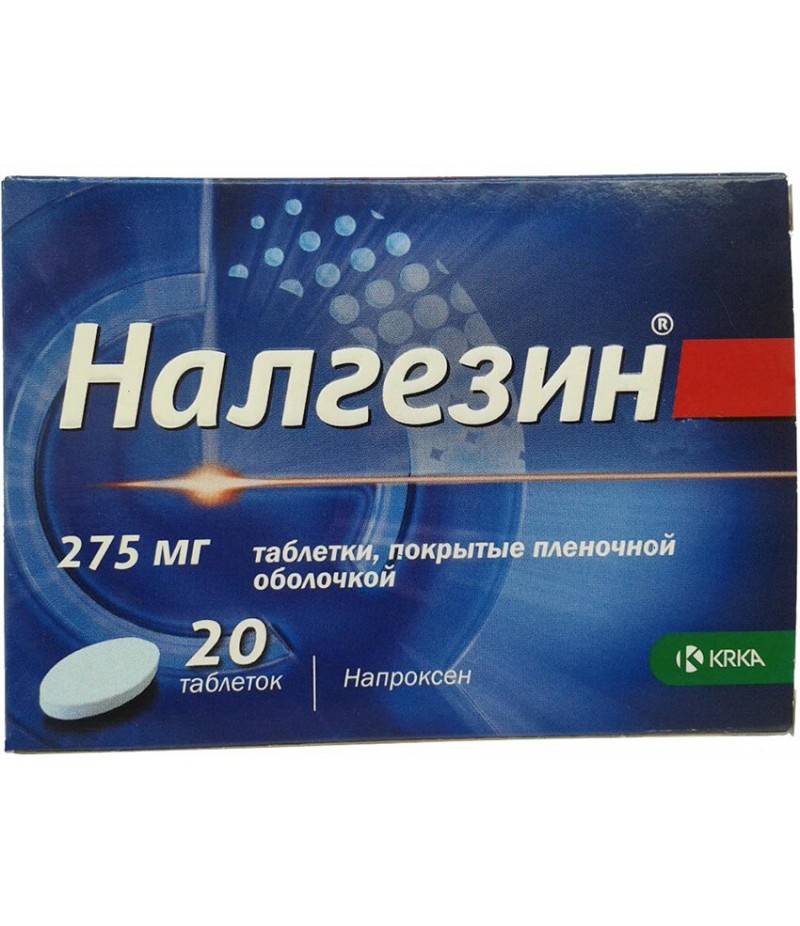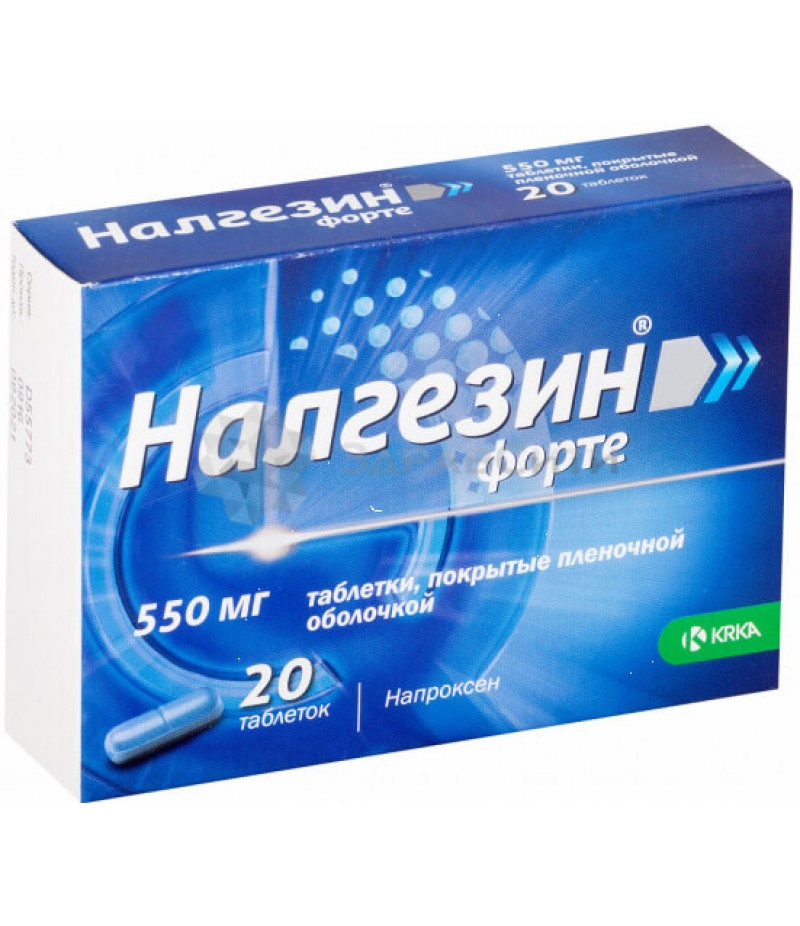Nalgesin tabs 275mg #20
- $14.19
- 3 or more $13.99
- Availability:In Stock
Nalgesin tabs instruction for useReed more and buy NalgesinCompositionThe tablet contains 275 mg of naproxen sodium; to auxiliary substances include povidone, MCC, magnesium stearate, as well as talc and purified water; The film s..
Tags: tabs
Nalgesin tabs instruction for use
Reed more and buy Nalgesin
Composition
The tablet contains 275 mg of naproxen sodium; to auxiliary substances include povidone, MCC, magnesium stearate, as well as talc and purified water; The film shell consists of an Opadry YS-1-4215 dye consisting of a ready mixture of macrogel, titanium dioxide (E171), as well as indigo carmine dye (E132) and hypromellose.
Form of issue
Film-coated tablets are packed in 10 blister packs, which, together with the recommendations for use, are placed in cardboard packs.
pharmachologic effect
Nalgesin is a non-steroidal anti-inflammatory drug that has antipyretic, analgesic, and anti-inflammatory effects.
Pharmacodynamics and pharmacokinetics
The mechanism of action is based on a non-selective inhibition of the activity of COX-1 and COX-2.
Tablets containing 275 mg of naproxen sodium are easily dissolved and absorbed quickly enough from the digestive tract. This ensures the onset of a rapid analgesic effect.
Bioavailability reaches more than 95% and the intake of food has absolutely no effect on both the speed and the completeness of absorption of the drug. The time to reach Cmax is about 1-2 hours.
Naproxen sodium has a very strong bond with plasma proteins. It reaches more than 99%. Css can be determined about 2-3 days of taking the medicine.
The process of metabolism of naproxen sodium takes place in the liver until the formation of dimethyl-naproxen and the enzyme group CYP2C9.
T1 / 2 is between 12 and 15 hours.
The clearance value is 0.13 ml / min / kg.
About 98% of the drug Nalgesin is excreted in the urine, and with bile - about 0.5-2.5%.
With renal failure, metabolites can accumulate.
Indications for use
It is recommended to use the preparation "Nalgesin" in the following types of pain syndrome:
with headache (migraine);
with toothache;
with spinal neuralgia (thoracalgia, lumboschialgia, cervicalgia);
with radicular pain;
with arthralgia;
in case of viral diseases;
with myalgia,
with primary dysmenorrhea.
Contraindications
It is not recommended to use the preparation "Nalgesin":
with severe renal failure;
with individual naproxen sodium intolerance;
with exacerbation of peptic ulcer of the stomach or duodenum;
with a tendency to bleeding from the gastrointestinal tract;
when oppression of bone marrow hematopoiesis;
during pregnancy and lactation.
Also, Nalgesin can not be categorically used in the treatment of children under the age of 9 and / or with a body weight not exceeding 27 kg.
Side effects
During treatment with Nalgesin, patients may experience severe discomfort from the following side effects:
From the digestive system:
from constipation, abdominal pain, dyspepsia, nausea, diarrhea, ulcerative stomatitis, erosive and ulcerative lesions and gastrointestinal bleeding, increased activity of hepatic enzymes, violations of liver function, jaundice, bloody vomiting, melena.
From the side of the central nervous system:
from hearing loss, dizziness, headache, drowsiness, depression, sleep disorders, inability to concentrate, insomnia, ailments, myalgia and muscle weakness, slow reaction, aseptic meningitis, cognitive dysfunction.
From the skin:
from itching, ecchymosis, increased sweating, purpura, alopecia, photodermatosis.
From the sense organs:
from noise in the ears, visual impairment, hearing impairment.
From the cardiovascular system:
from puffiness, dyspnea, palpitation, congestive heart failure, vasculitis.
From the genitourinary system:
from glomerulonephritis, hematuria, interstitial nephritis, nephrotic syndrome, renal failure, renal papillary necrosis, menstrual irregularities.
From the hematopoiesis:
from eosinophilia, granulocytopenia, leukopenia, thrombocytopenia, aplastic anemia.
From the respiratory system:
from eosinophilic pneumonitis.
Allergic reactions:
from skin rash, hives, angioedema, epidermal necrosis, erythema multiforme, Stevens-Johnson syndrome.
Other:
from thirst, hyperthermia, hyperglycemia, hypoglycemia, hemolytic anemia.
Instructions for use Nalgesin (Method and dosage)
In this manual, the number of tablets is given for simple Nalgesin, which contains 275 mg of naproxen sodium. When taking Nalgesin Forte, which contains 550 mg of naproxen sodium, the number of tablets should be reduced by a factor of 2.
Tablets are taken orally, squeezed with a sufficient amount of liquid.
In case the drug is used as an analgesic, the daily dose should not exceed 4 tablets. The optimal average dose is 550-1100 mg.
With very severe pain, you can take a shock dose of 2 Nalgesin tablets. But instructions for use (especially the section "Contraindications") in this case, the drug should be studied in detail. It is allowed to take 6 tablets per day, i.e. 1650 mg of naproxen sodium, but not more than 2 weeks.
If Nalgesin is used as an antipyretic drug, then its initial dose should be 2 tablets (550 mg), and then take 1 tablet (275 mg) every 6-8 hours.
In order to prevent migraine attacks, you must take 2 tablets (550 mg) 2 times a day. But treatment under this scheme should be necessarily stopped, if for 4-6 weeks of taking the drug, migraine attacks will not decrease. Many doctors advise at the first signs of a headache to take just 3 tablets, ie 825 mg of naproxen sodium, and if necessary after 30 minutes take another 1-2 tablets of the drug.
In order to alleviate menstrual pain and cramping, it will be enough to take 2 tablets (550 mg) for the first time, and then reduce the dose twice and take 1 tablet (225 mg) every 6-8 hours.
In case of an acute attack of gout, the initial dose may be 3 tablets, ie 825 mg of naproxen sodium, then take 8 hours 2 tablets later, and then take every 8 hours for 1 tablet until the seizure is completely stopped.
In arthritis, osteoarthritis and ankylosing spondylitis, the first dose of the drug should be 2-4 tablets (550-1100 mg) in 2 divided doses (morning and evening).
Take from 3 (825 mg) to 6 tablets (1650 mg) of Nalgesin can patients suffering from severe night pain or severe morning stiffness. Please note that in this case, it is necessary to consult with the attending physician, who can change the dose depending on what symptoms prevail in the patient.
Children who have already reached the age of 9 years and / or their body weight is already more than 27 kg Nalgesin is prescribed at 10 mg / kg in 2 divided doses per day.
Overdose
In case of overdose with Nalgesin, the patient may experience discomfort from the following symptoms:
from drowsiness;
from dyspeptic disorders (heartburn, nausea and vomiting, abdominal pain);
from general weakness;
from noise in the ears;
from irritability.
And in severe cases, the patient may even suffer:
from bloody vomiting;
from melena;
from impaired consciousness;
from seizures;
from renal insufficiency.
Treatment for overdose is to make the gastric lavage as quickly as possible and to carry out symptomatic therapy with activated charcoal, antacids, histamine H2 receptor blockers, proton pump inhibitors. Note that hemodialysis with an overdose of Nalgesin is ineffective.
Interaction
With the simultaneous administration of anticoagulants with Nalgesin it should be remembered that naproxen significantly increases the time of bleeding.
It is not recommended to use Nalgesin together with other NSAIDs, as this can cause side effects.
Patients who are simultaneously treated with hydantoins, anticoagulants, or other drugs that bind to plasma proteins should ensure that there is no overdose of these drugs.
The drug Nalgesin can cause a decrease in the antihypertensive effect of propranolol, as well as other beta-blockers. The drug significantly increase the risk of kidney failure in the case of simultaneous use with ACE inhibitors.
Under the action of Nalgesin, the natriuretic effect of furosemide can be inhibited.
The concentration of lithium in plasma can be increased by inhibiting renal clearance.
And taking probenecid can trigger an increase in the level of naproxen in the plasma.
Naproxen may cause a decrease in the excretion of phenytoin, methotrexate and sulfonamides, which may lead to the development of their toxic effects.
Ciclosporin, reacting with naproxen, provokes the development of renal failure.
Antacid preparations, which have magnesium and aluminum in their composition, can significantly reduce the absorption of naproxen.
Terms of sale
You can buy Nalgesin without prescription.
Storage conditions
Nalgesin should be stored in a dry and inaccessible place for children at a temperature not exceeding 25 degrees Celsius.
Shelf life - 5 years.
Reviews about Nalgesin
The average rating of Nalgesin at the forums is 4.3 on a 5-point scale.
The visitors of the forum consider the advantages of the drug as:
quickly removes pain;
helps with spasms in critical days;
gives a long effect;
is dispensed without a doctor's prescription.
Disadvantages of Nalgesin participants of the discussion:
a huge number of side effects;
sufficiently high price;
inefficiency.
Reviews of doctors: from what tablets Nalgesin save and why Nalgesin Forte is more effective?
Analyzing the reviews about Nalgesin doctors, we can conclude that at the moment Nalgesin is a very popular anesthetic that can quickly and permanently remove any pain.
Also, experts confirm the information that Nalgesin Forte has a stronger effect and a quick effect, but not due to the fact that it contains some additional substances, but due to the fact that Nalgesin Forte tablets contain twice as much naproxen sodium .



